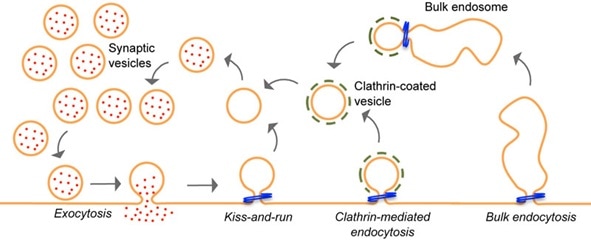|
Neurons make connections with one another through specialised structures, known as synapses, which are the points of contact between axonal nerve terminals (presynaptic) and dendrites (postsynaptic). Neuronal communication starts when an action potential arrives at the presynaptic nerve terminal, triggering the release of chemical messengers or neurotransmitters, which in turn activate or silence the postsynaptic neurons once bound to the neurotransmitter receptors. Subsequent calcium influx into the postsynaptic neuron further triggers signalling cascades not only locally at the site of calcium entry but also propagates to induce transcriptional programming of gene expression in the nucleus.
Our research program seeks to understand key events in the pre synapse (presynaptic vesicle recycling), post synapse (glutamate receptor trafficking), and nucleus (RNA-mediated epigenetic regulation) during synaptic plasticity. |
Presynaptic Vesicle Recycling
|
Live-cell synaptophysin-pHluorin (SypHy) imaging of synaptic vesicle recycling in primary hippocampal neurons.
|
Neurotransmitters are packaged inside synaptic vesicles within axonal terminals. A typical nerve terminal contains a small number of vesicles, only enough to maintain about 5-10 seconds of neurotransmission. Thus, synaptic vesicle membrane proteins and lipids must be retrieved and recycled by endocytosis in order to maintain the fidelity of synaptic transmission. We are investigating roles of BAR domain containing proteins that are capable of lipid binding in controlling synaptic vesicle recycling and how their functions are modulated by the rapid and reversible post-translational modifications, such as protein phosphorylation and ubiquitination. In addition, we are also interested in the regulation of synaptic vesicle exocytosis in mammalian central neurons, focussing on the function of the SNARE complex and its interacting proteins.
|
Postsynaptic glutamate receptor trafficking

Glutamate is the major excitatory neurotransmitter in the brain. The AMPA-type glutamate receptors are the principal receptors that mediate most of the fast excitatory synaptic transmission in the mammalian brain. Dynamic trafficking and proper synaptic targeting of AMPA receptors are crucial in determining the strength and plasticity of excitatory synaptic transmission. We seek to determine the molecular mechanisms underlying the precise membrane trafficking and endosomal sorting of AMPA receptors, focusing on their regulation by novel AMPA receptor interacting proteins and post-translational modifications, and to understand their impact in synaptic plasticity, learning and memory.
|
|
(Top) Gcamp6f calcium-imaging in dendritic spines and (Left) NMDA-induced internalisation and recycling of pH-GluA2 in cultured hippocampal neurons.
|
Roles of Regulatory RNA in Synaptic Plasticity
|
The regulation of RNA is fundamental to cellular biology. Two aspects of RNA biology have recently emerged: a, that the majority of our genome is not translated but left as non-coding RNAs with potential functions that vastly remain to be characterised; b, all classes of RNA are dynamically modified (epitranscriptomic regulation) which can determine their fate at any stage following their initial synthesis in the nucleus to their translation and/or degradation in the cytoplasm. We seek to understand the functions and mechanisms of actions of these RNA regulations in synaptic plasticity, learning and memory. We are tackling these questions using RNA-seq based approaches, as well as molecular, cellular, biochemistry and mouse behavioural assay.
|

